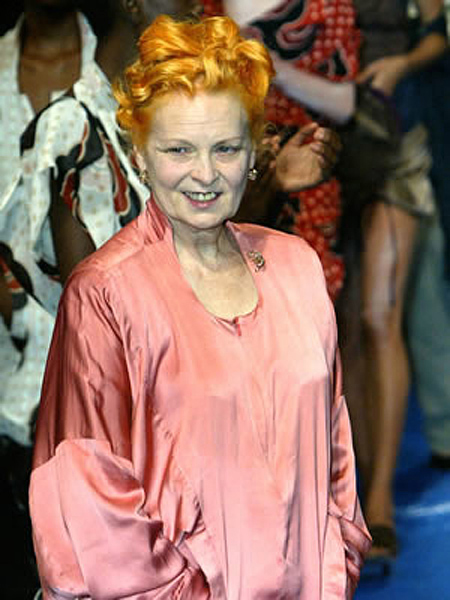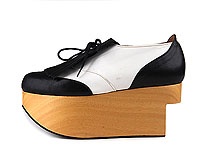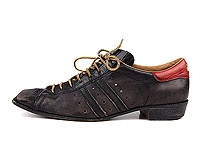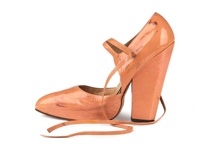Resources / Designers / Westwood, Vivienne

Westwood, Vivienne
Vivienne Westwood is one of the most extraordinary, controversial and at the same time influential and recognisable British designers of the past 30 years.
She was born as Vivienne Isabel Swire in Glossop, Derbyshire, on April 8, 1941, the first child of Dora Ball and Gordon Swire. In 1957 her family moved to Station Road, Harrow (NW London). Vivienne studied one term at Harrow Art School, then attended a teacher-training college and became a primary-school teacher in Willesden, North London. In 1962 Vivienne married Derek Westwood and a year after her son, Benjamin Arthur Westwood, was born. Three years later their marriage broke, as Vivienne felt that her life was getting frustratingly circumscribed.
Through her brother Gordon she met in 1965 Malcolm Edwards (as McLaren was called until 1971) who channelled her latent creativity into fashion. She began designing clothes in 1971 with the opening of her first shop, Let It Rock, at 430 King's Road. The shop underwent several changes of name (Too Fast to Live, Too Young To Die) and style until it emerged in 1974 under name of Sex, a boutique selling bondage gear, ripped T-shirts and other attire that became synonymous with the punk explosion.
In 1976, her then lover and business partner, Malcolm McLaren, guaranteed her status among the stars when he dressed the Sex Pistols, the British band he managed, in clothes from the boutique. By the time the punk storm had passed at the end of the Seventies, Westwood was already recognised as a frontrunner among fashion's avant-garde.
Westwood's first runway show was the Pirate collection in London, in March 1981. Her design style had evolved so that her main interests included not only the youth and street culture but also tradition and technique. Meanwhile, in 1980 the shop was renamed World's End, and in 1981 Westwood began to show her collections in Paris, finally recognized internationally as a major designer. In 1982 she presented The Savages Collection, introducing a tribal look with oversized clothes in rough fabrics with exposed seams. Her subsequent collections were called Buffalo, Hoboes, Witches, and Punkature and continued Westwood's postmodern array of unmatched objects and patterns. In 1985 Westwood launched her "mini-crini," a short hooped skirt inspired by the Victorian crinoline, and styled with a tailored jacket and platform shoes. In 1990, by now more concerned with haute couture than streetstyle, Westwood launched a menswear collection in Florence. In the same year, she was named British Designer of the Year, a feat she repeated in 1991. The following December, she was awarded an Order of the British Empire in recognition of her services to British fashion. Her use of quintessentially British wools, tweeds, tartans and linens continues to make her a byword for British style and quality abroad; and in 1998 she won the Queen's Export Award.
Among other honours, Westwood also was awarded a place in the Victoria & Albert museum, with the indigo mock croc lace-up platform boots that famously toppled Naomi Campbell on the catwalk in 1993. When in 1999 Queen Elizabeth II went to view the collection, wearing sensible court shoes, she was heard to mutter: "I'm not surprised she fell."
This pair of platform 'gillie' shoes is typical of her quirky designs that reinterpret traditional dress. Apart from the type of lacing at the vamp, Westwood's shoes bare little resemblance with the traditional gillie worn by Scottish Highland dancers. Rather, Westwood's shoes with their extreme heel and concealed plaform are reminiscent of fetish footwear. The juxtaposition of the traditional with the taboo is characteristic of Westwood's subversive designs.
The shoes were designed as part of Westwood's Anglomania' collection Autumn/Winter 1993 and received much publicity when the supermodel, Naomi Campbell fell on a London catwalk when wearing them. Westwood first designed shoes when she was in partnership with Malcolm McLaren. For their shop 'Sex' they sold stiletto shoes with leopard print uppers inspired by 1950s design. When her own label was established in 1980, Westwood designed two new shoes for each collection until 1988 when she standardized her shoe designs. With each collection since then, she has gradually exaggerated the basic style. The 'Super elevated gillie', which has a 9-inch heel and 4 inch platform, was originally shown in the 'Portrait' collection of 1990. Westwood gets her handmade shoes made in the East End of London.
BRANDS:
Vivienne WestwoodEXHIBITS (4):



